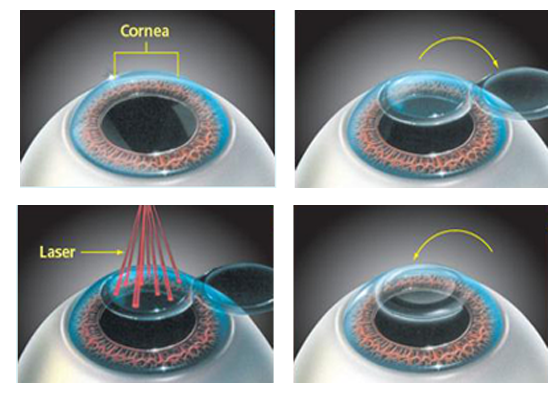-
Appointment
+91-9819186640 -
Email
specialityeyeclinic@gmail.com -
Monday - Saturday
11.00 am to 07.30 pm
LASIK is a revolutionary eye treatment, the highlight of which is that by a safe & short procedure (just 10 minutes) one can get rid of spectacles or contact lenses. This treatment is carried out with the help of a hi-tech computer controlled Excimer laser which is preprogrammed to remodel the shape the cornec with a great degree of precision & help in correcting refractive errors.
Anyone who wears spectacles or contact lenses can undergo this treatment but this treatment is usually recommended after 18 years of age when the eyeball stops growing. Even after this age refractive error should be stable over a period of 1 year before this treatment is contemplated.
Situations where LASIK is not recommended:

The entire process takes about 10-15 minutes of
which the laser treatment itself takes only a few
seconds. The treatment is not painful as the cornea is
made numb with eye drops. No injections are given.
Only there might be a slight discomfort during & after
the procedure. The treatment is extremely safe & also
the patient can go home after the treatment within half
an hour.
In Myopia where patients can see near objects clearly but distance vision is blurred, the laser beam is directed at the central part of the cornea to flatten its curvature. In hypermetropia where distance vision is clear but near vision is blurred, the laser beam is directed at midperipheral cornea so as to make the cornea steeper. In Astigmatism where the curvature of cornea is irregular causing distorted images the laser beam is directed obliquely so as to smoothen the corneal surface.

Yes. Preoperative corneal tests like topography
(corneal mapping) & pachymetry (corneal thickness)
measurement along with retina evaluation & dryness
measurement tests are mandatory to find out whether
eyes are safe to undergo lasik.

There is usually no chance of getting the numbers back.
LASIK can be & is usually done on both eyes on the same day one after another & it is infact advisable to do so as the visual recovery is faster & there is no post operative double vision.
The reliability of LASIK is very good in mild to moderate levels of refractive errors but with very high degree of refractive errors (number above - 10), the variability is more & some people may still need glasses, though of lesser power. The results are excellent in myopia (minus numbers) as compared to hypermetropia (plus numbers) LASIK
Technique Can Correct:
LASIK treatment is a USFDA approved procedure which has no sight threatening complications Minor complications are mild intolerance to light for the first few days post LASIK. Also there could be glare & haloes while driving at night which settle down in a few days as the flap heals. There could be dryness of eyes which subsides with the healing of cornea.
Usually the patient can get back to work in 1-2 days without any problem. There are certain specific Do's and Don'ts after undergoing LASIK. They include.


© 2021 All Rights Reserved www.specialityeyecare.com | Powered by : A-WEBSOLUTIONS